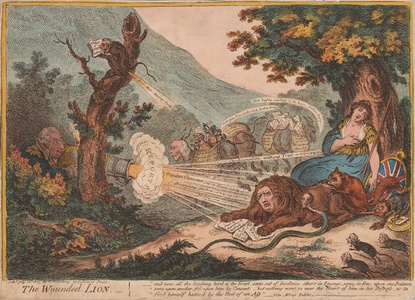| Method | Etching with early hand colouring |
| Artist | James Gillray |
| Published | Pubd. July 16th 1805 by H. Humphrey, 27 St James's Street. |
| Dimensions | Image 257 x 360 mm, Plate 260 x 360 mm, Sheet 265 x 362 mm |
| Notes |
A satirical defence of Henry Dundas, 1st Viscount Melville, and a comment more broadly about the impact of factionalism on the Admiralty during a time when the nation was at war with France. Dundas, wearing a mournful expression, is presented as a lion, attacked and set upon from all sides. The lion's chief antagonist is John Jervis, 1st Earl of St Vincent, who, crouching in ambush behind a tree, fires a colossal cannon or blunderbuss at Dundas, the shot issuing from a cloud of smoke titled 'Reports' and the scattershot labelled with the various methods used to impeach Dundas, 'Malice,' 'Disappointed Jacobins,' 'Popular Clamour,' 'Envy,' and 'Invectives.' The muzzle of the gun is a tankard carrying the label 'Whitbread's Entire,' and a stray shot, labelled 'Condemnation without Trial' has struck the ailing figure of Britannia in her breast. She slumps against a tree behind the lion, blood dripping from the wound. Dundas' impeachment came about as a direct result of St Vincent's attempts to stamp out corruption in his time as First Lord of the Admiralty. Melville was cleared, though St Vincent's actions earned the ire of Prime Minister William Pitt, and he was himself forced to resign in the year following the issuing of this satire, to be replaced as First Lord by Dundas, Pitt's trusted lieutenant. The Foxites, Pitt's enemies, are also in evidence, with Fox (as a fox) biting the lion's hindquarters, and a snake with the head of Grey hissing in the lion's ear. A trio of rats wearing the wigs of lawyers, Jekyll, Erskine, and Adair, also run towards the conflict, while a dog, Kinnaird, bites the tail of Fox. In the background, three donkeys, with the heads of Sidmouth, Addington, and Bragge, flee in fright, carrying with them their loads: 'Physick for the Lion,' which includes a clyster, an emetic, and a tin of Opening Pills, a sack of 'Candied Whorehound,' and finally two paniers worth of 'Provisions for the Doctor's Family' and 'Trifles procured thro' the Lion's Generosity.' A final insult is issued by a monkey with the face of William Wilberforce, a supporter of Addington, who reads a pamphlet entitled 'Solution of Vital Xtianity' while passing wind at the lion, issuing forth with the titles 'Cant! Envy! Abuse!, Hypocrisy! Cruelty!' Below the scene, a lengthy inscription reads: '"And now all the sculking herd of the forest, some out of Insolence, others in Revenge, some, in fine, upon one Pretence," / "some upon another, fell upon him by Consent. _ but nothing went so near the Heart of him in his Distress, as to" / "find himself batter'd by the Heel of an Ass" _ Vide, Aesop's Fables.' James Gillray (c.1756-1815), was a British caricaturist and printmaker famous for his etched political and social satires. Born in Chelsea, Gillray studied letter-engraving, and was later admitted to the Royal Academy where he was influenced by the work of Hogarth. His caricature L'Assemblée Nationale (1804) gained huge notoriety when the Prince of Wales paid a large sum of money to have it suppressed and its plate destroyed. Gillray lived with his publisher and print-seller Miss (often called Mrs) Humphrey during the entire period of his fame. Twopenny Whist, a depiction of four individuals playing cards, is widely believed to feature Miss Humphrey as an ageing lady with eyeglasses and a bonnet. One of Gillray's later prints, Very Slippy-Weather, shows Miss Humphrey's shop in St. James's Street in the background. In the shop window a number of Gillray's previously published prints, such as Tiddy-Doll the Great French Gingerbread Maker [...] a satire on Napoleon's king-making proclivities, are shown in the shop window. His last work Interior of a Barber's Shop in Assize Time, from a design by Bunbury, was published in 1811. While he was engaged on it he became mad, although he had occasional intervals of sanity. Gillray died on 1 June 1815, and was buried in St James's churchyard, Piccadilly. BM Satires 10421 Condition: Trimmed to platemark. Two repaired tears to inscription space. Small puncture above 'Heart' in inscription. Minor chips to edges of sheet. Old adhesive stains and album paper on verso. |
| Framing | unmounted |
| Price | £975.00 |
| Stock ID | 51754 |

